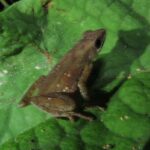- Exploring the Enigmatic Life of Ischnocnema bolbodactyla: Brazil's Elusive Forest Dweller
- Taxonomy and Classification: A Unique Member of Brazil's Amphibian Family
- Natural Habitat: Life Amongst Leaf Litter in the Atlantic Forest
- Physical Characteristics: Master of Subtle Camouflage
- Behavior and Life Cycle: Subtle Beginnings and Secret Songs
- Ecological Role: A Key Actor in Forest Health
- Threats and Conservation Status: Navigating a Precarious Future
- Cultural and Scientific Significance: A Symbol of Forest Vitality
- Conclusion: Protecting the Tiny, Unseen Wonders of the Atlantic Forest
Exploring the Enigmatic Life of Ischnocnema bolbodactyla: Brazil’s Elusive Forest Dweller#
Tucked within the lush tapestry of Brazil’s Atlantic Forest, a small, inconspicuous amphibian named Ischnocnema bolbodactyla quietly thrives. Often overshadowed by larger and more colorful rainforest creatures, this elusive frog hides fascinating secrets beneath an unassuming exterior. With a name that rarely makes headlines, Ischnocnema bolbodactyla offers an enchanting glimpse into the unique adaptations and survival strategies of tropical forest amphibians.
Unlike their brightly colored relatives, this modest brownish frog embodies a subtler charm—finding its place amid leaf litter and dense vegetation. But underneath its understated appearance, it harbors adaptations and behaviors that captivate scientists and nature enthusiasts alike. From its cryptic coloration to its quirky reproductive strategies, Ischnocnema bolbodactyla demonstrates how evolution has delicately shaped life amidst the shadows of towering canopy giants.
Taxonomy and Classification: A Unique Member of Brazil’s Amphibian Family#
Ischnocnema bolbodactyla belongs to the family Brachycephalidae, grouping it among some of Brazil’s most enigmatic amphibians. First scientifically described by André Marie Constant Duméril and Gabriel Bibron in 1841, the species finds itself nestled within a fascinating and diverse genus characterized by unique adaptations, including direct-developing eggs—a remarkable survival strategy within rainforests.
Position Within Its Genus and Family#
The genus Ischnocnema encompasses numerous small terrestrial frogs that predominantly inhabit tropical and subtropical ecosystems across eastern Brazil. Closely related sibling species often exhibit similarly modest appearances, making clear identification a subtle art. Yet, careful morphological and genetic studies have cemented I. bolbodactyla as a distinct species with unique evolutionary pathways.
Notably absent from the dramatic coloration or flamboyant patterns seen in tree frogs, members of Brachycephalidae evolved subdued tones to seamlessly blend into their forest floor habitats, relying on stealth and camouflage rather than toxicity or vivid warnings to thwart predators. This evolutionary choice defines their ecological niche—a fascinating example of subtle survival.
Natural Habitat: Life Amongst Leaf Litter in the Atlantic Forest#
Tucked safely beneath dense canopies and tangled roots in the Atlantic Forest—the crucial biodiversity hotspot along Brazil’s southeastern coastline—Ischnocnema bolbodactyla has quietly perfected life on the rainforest floor. The humid, shaded understory, draped in perpetual twilight and blanketed by layers of decayed leaves, provides its ideal home.
A Forest Floor Specialist#
Where many amphibians frequent streams and ponds to breed, this terrestrial frog remains steadfastly bound to solid ground. Moisture-rich leaf litter creates a picturesque background of continual decay and regeneration, where fungus flourishes, insects abound, and conditions for direct egg development thrive.
Observations suggest its habitats range from primary forests to secondary-growth vegetation—a testament to its adaptability. While they typically favor undisturbed forests for optimal population health, they demonstrate resilience by accelerating their lifecycles in regenerating or disturbed areas to evade predation and environmental pressures. Such adaptability highlights nature’s resilience even amidst pressures from human intrusion and environmental changes.
Physical Characteristics: Master of Subtle Camouflage#
Though modest and unassuming, the physical appearance of Ischnocnema bolbodactyla encapsulates its stealthy survival strategy. Averaging between 20–30 millimeters in length, with females typically larger than males, it showcases the quintessential physique of a small rainforest-bound amphibian.
Cryptic Coloration for Survival#
Its mottled shades of browns and greys, occasionally punctuated by subtle olive hues, render it nearly invisible against the forest floor. Minute irregular patterns resembling dried leaves and scattered bark fragments serve as flawless camouflage against sharp-eyed predators such as birds and reptiles. It represents nature’s artistry at its utmost subtlety: a delicate blend into the habitat balanced on the razor’s edge of survival.
Its compact body and robust limbs, dotted with coarse texture, provide stability and agility amidst damp leaves and tangled roots. The species-specific identifier—its bulbous fingertips (“bolbodactyla” literally means “bulbous-fingered”) — is a key morphological trait. Small rounded toe pads enhance climbing abilities, allowing escape and retreat into vertical refuges in emergency situations, even though they predominantly dwell terrestrially.
Behavior and Life Cycle: Subtle Beginnings and Secret Songs#
Notable behavior reveals itself most vividly during twilight hours. As nightfall descends, males take positions on strategic perches within undergrowth, issuing calls described as soft, repetitive notes. Their modest vocalizations, akin to gentle taps against a hollow log, resonate through the forest understory as mating invitations to listening females nearby. The subtle chorus forms a delicate nocturnal melody rarely heard but essential to their species’ continuation.
A Unique Reproductive Strategy: Direct Development#
Rather than depositing eggs in water like most frogs, females lay small clutches of eggs carefully concealed beneath damp leaves and logs. Remarkably, offspring bypass an aquatic tadpole phase altogether. Eggs directly hatch into miniature froglets—complete miniatures of their parents.
This direct-developing lifecycle provides enormous evolutionary advantages. Freed from aquatic predators and water-dependent breeding locations, these offspring are immediately ready for life amidst the leaf litter, perfectly adapted to terrestrial existence from day one. This remarkable adaptation has allowed them to carve out a resilient niche in otherwise highly competitive ecosystems.
Ecological Role: A Key Actor in Forest Health#
Through its daily interactions, Ischnocnema bolbodactyla maintains incredibly valuable roles within the Atlantic Forest ecosystem. As both predator and prey, the species contributes fundamentally to ecological stability.
Regulating Small Arthropod Communities#
A voracious eater of insects, spiders, and other invertebrates, this tiny frog acts as an effective control against populations of arthropods. By managing these abundant fauna, it indirectly supports vegetation health and balance in soil nutrients and plant pollination—illustrating the interconnected web of forest life where even the humblest inhabitants exert critical impacts.
A Vital Source of Prey and Energy Transfer#
Conversely, it nourishes several predators. Birds, snakes, and small mammals rely partially on frogs like Ischnocnema bolbodactyla for food. Their presence fuels higher trophic levels, transmitting the energy stored in arthropod prey up through the forest food web—an indispensable connection that, once severed, could ripple destructively throughout entire ecological systems.
Threats and Conservation Status: Navigating a Precarious Future#
The survival of Ischnocnema bolbodactyla hinges critically upon preservation of its Atlantic Forest habitat—a biome drastically fragmented by agriculture, urbanization, and logging. The current IUCN classification notes the species as Least Concern, suggesting relative stability. However, rapid habitat degradation places it continually at edge, potentially shifting status toward more alarming designations if human pressures persist unchecked.
Challenges of Habitat Fragmentation and Degradation#
The transformation of primary forests into pastureland or agricultural fields massively disrupts the subtle balance that sustains delicate amphibian populations. Fragmentation isolates populations into small patches, increasing chances of genetic drift, disease susceptibility, and local extinctions.
Cultural and Scientific Significance: A Symbol of Forest Vitality#
While not symbolic in traditional folklore, its presence and health offer powerful indications of ecosystem integrity. Scientists depend on forest frogs like this species as bioindicators—organisms whose thriving abundance signals stable, healthy environments free from dangerous pollution or imbalance. Likewise, declines in their populations send urgent warnings of underlying ecological disruption, emphasizing their importance in scientific assessments of environmental health.
Conclusion: Protecting the Tiny, Unseen Wonders of the Atlantic Forest#
The humble presence of Ischnocnema bolbodactyla underscores the wonder hidden within Brazil’s mesmerizing Atlantic Forest. Each aspect from morphology to lifecycle—so uniquely adapted to their terrestrial niche—paints a vivid picture of evolutionary genius shaping resilience amidst the forest’s deepest shadows.
As stewards of biodiversity, protecting these understated yet profoundly valuable frogs encompasses safeguarding entire habitats. Encouraging ecological awareness, advocating conservation action, and supporting habitat preservation become our collective calling. Let their silent lives teach us—every small heartbeat in nature matters profoundly. With mindful dedication and informed action, we can keep this tiny forest wanderer leaping gently along rainforest floors for generations to come.







